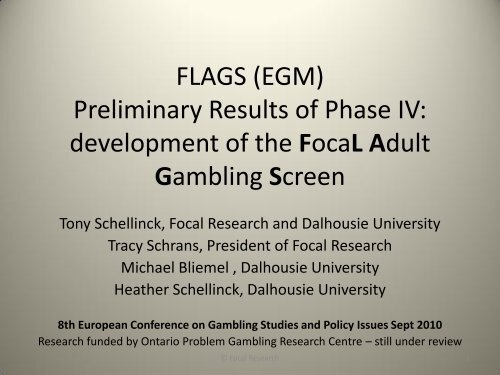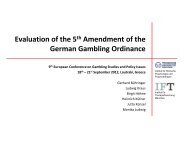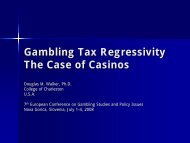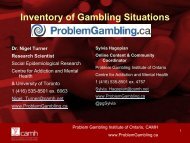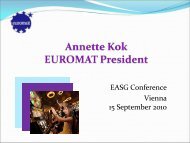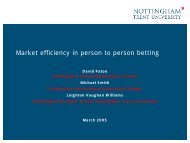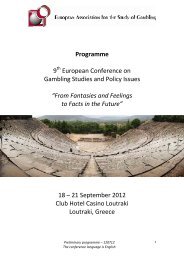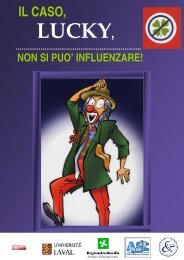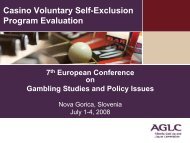FLAGS - European Association for the Study of Gambling
FLAGS - European Association for the Study of Gambling
FLAGS - European Association for the Study of Gambling
You also want an ePaper? Increase the reach of your titles
YUMPU automatically turns print PDFs into web optimized ePapers that Google loves.
<strong>FLAGS</strong> (EGM)Preliminary Results <strong>of</strong> Phase IV:development <strong>of</strong> <strong>the</strong> FocaL Adult<strong>Gambling</strong> ScreenTony Schellinck, Focal Research and Dalhousie UniversityTracy Schrans, President <strong>of</strong> Focal ResearchMichael Bliemel , Dalhousie UniversityHea<strong>the</strong>r Schellinck, Dalhousie University8th <strong>European</strong> Conference on <strong>Gambling</strong> Studies and Policy Issues Sept 2010Research funded by Ontario Problem <strong>Gambling</strong> Research Centre – still under review© Focal Research1
Our Vision<strong>FLAGS</strong> (EGM) is <strong>the</strong> next generation <strong>of</strong>measurement <strong>for</strong> adult gambling risk andharm specifically designed <strong>for</strong> public healthsurveillance. <strong>FLAGS</strong> moves beyondtraditional identification <strong>of</strong> problemgambling prevalence providing in<strong>for</strong>mation<strong>for</strong> use in in<strong>for</strong>ming, monitoring andevaluating gambling related prevention,harm reduction, social policy and publichealth policy <strong>for</strong> youth.© Focal Research2
Our Purpose: Public Health Surveillance• According to <strong>the</strong> World Health Organization (WHO) Public HealthSurveillance is “<strong>the</strong> ongoing, systematic collection, analysis andinterpretation <strong>of</strong> health-related data essential to <strong>the</strong> planning,implementation, and evaluation <strong>of</strong> public health practice”• The primary goals <strong>of</strong> surveillance as defined by WHO are:– To serve as an early warning system - measure risk– Guide public health policy and strategies – Provide actionablein<strong>for</strong>mation– Document <strong>the</strong> impact <strong>of</strong> an intervention or progress towards specifiedpublic health targets/goals – Be highly accurate and consistent– Understand and monitor <strong>the</strong> epidemiology <strong>of</strong> a condition in order to setpriorities and guide public health policy and strategies – be causallyrelated and detailed enough <strong>for</strong> policy development© Focal Research• http://www.who.int/immunization_monitoring/burden/routine_surveillance/en/index.html3
Why is <strong>FLAGS</strong> (EGM) needed?• Current screens are probably reasonably accurate in identifyingadults who are suffering more severely from <strong>the</strong> effects <strong>of</strong>gambling. However, <strong>the</strong>se instruments were not designed toidentify gamblers who may be at different risk levels or to providedetailed in<strong>for</strong>mation to <strong>the</strong> decision maker. Moreover, <strong>the</strong> goal is touse surveillance to in<strong>for</strong>m, monitor and evaluate it is equallyimportant to know ‘why’ a person is at risk especially if <strong>the</strong> goal isto help <strong>the</strong>m.• <strong>FLAGS</strong> is designed to do just that. <strong>FLAGS</strong> also more accuratelyassigns adults to a problem gambling category as it has a largerinventory <strong>of</strong> consequences than o<strong>the</strong>r screens as well as a measure<strong>of</strong> persistence that helps to overcome <strong>the</strong> transient nature <strong>of</strong> adultbehaviour and properly define a problem gambler.• Because all <strong>of</strong> <strong>the</strong> constructs are multi-item measures that arereliable and valid, <strong>the</strong> <strong>FLAGS</strong> instrument allows <strong>for</strong> accuratecomparisons among jurisdictions <strong>of</strong> <strong>the</strong> prevalence <strong>of</strong> problemgambling and perhaps more importantly <strong>the</strong> extent to which <strong>the</strong>existing adult populations are at risk <strong>of</strong> developing problemgambling.© Focal Research4
What is <strong>the</strong> FocaL Adult <strong>Gambling</strong>Screen (<strong>FLAGS</strong>)?• <strong>FLAGS</strong> (EGM) is a new survey instrument designed toga<strong>the</strong>r adult EGM gambling in<strong>for</strong>mation in order to in<strong>for</strong>msocial and public health policy.• ≈ 58 statements• Ten Constructs that provide indications <strong>of</strong> risk or problemgambling• A scoring system that allots people to one <strong>of</strong> five categoriesbased <strong>the</strong>ir being flagged on a combination <strong>of</strong> indicators• A reporting system - set <strong>of</strong> predesigned analyses that willprovide in<strong>for</strong>mation necessary <strong>for</strong> decision makers– Validity and reliability checks <strong>of</strong> <strong>the</strong> constructs and <strong>the</strong>irrelationships in <strong>the</strong> setting it was administered– The prevalence and pr<strong>of</strong>iles <strong>of</strong> <strong>the</strong> each risk category© Focal Research5
<strong>FLAGS</strong> Five Levels <strong>of</strong> Player Risk <strong>for</strong> Machine <strong>Gambling</strong>Risk Level Label DescriptionLevel V Problem Gambler A Problem Gambler is a person who flagged as exhibiting bothNegative Consequences and Persistence.Level IVLevel IIILevel IIAdvanced RiskIntermediate RiskEarly RiskThose at Advanced Risk are not flagged as a problem gamblerbut have one or more indications on <strong>the</strong> five constructsranked highest in <strong>the</strong> hierarchy score: Impaired Control:Begin, Preoccupation: Obsessed, Risky Practices: Later,Negative Consequences and Persistence.Those at Intermediate Risk are not Problem or Advanced Riskgamblers, but have been flagged on one or more <strong>of</strong> <strong>the</strong>intermediate risk constructs: Impaired Control: Continue andRisky Practices: Earlier.Those at Early Risk have flagged on at least one <strong>of</strong> RiskyCognitions: Beliefs, Risky Cognitions: Motives orPreoccupation: Desire.Level I No RiskThose at No Risk do not flag on any <strong>of</strong> <strong>the</strong> risk indicatorsalthough it is possible that <strong>the</strong>y answered yes to one or morestatements making up some <strong>of</strong> <strong>the</strong> constructs.Level 0 Non-gambler A Non-Gambler by definition is at no-risk because <strong>the</strong>y are© Focal Researchnot involved in <strong>the</strong> activity over <strong>the</strong> last year.6
How was <strong>the</strong> <strong>FLAGS</strong> developed andtested?Built on earlier work, 1998 NS VLT study, 2000 Follow-up study, SAPGSdevelopment <strong>for</strong> <strong>the</strong> Victoria <strong>Gambling</strong> Research Panel (2004) and <strong>the</strong>quantitative testing phase <strong>for</strong> <strong>the</strong> Victoria Department <strong>of</strong> Justice (2006).Phase I – literature review <strong>of</strong> method bias in measures– funded by OPGRCPhase II – Literature review <strong>of</strong> Formative versus Reflective constructs – fundedby OPGRCPhase III – qualitative and preliminary quantitative research on 190 statementsand constructs that were eventually rejected (e.g., superstitions) with 63casino gamblers in Ontario – 2008 – funded by OPGRCPhase IV 2009 - 10 quantitative analysis <strong>of</strong> responses to 132 statements to<strong>for</strong>mulate <strong>FLAGS</strong> (EGM) beta – 384 Ontario Casino Gamblers – Funded byOPGRCPhase V 2010 - Fur<strong>the</strong>r quantitative refinement <strong>of</strong> instrument and testing onVLT gamblers – 500 VLT gamblers – funded by Nova Scotia <strong>Gambling</strong>Foundation – report due End <strong>of</strong> September 2010© Focal Research7
Preoccupation:DesireReflectiveImpairedControl:ContinueReflectiveFormative and ReflectiveConstructs: <strong>FLAGS</strong>ImpairedControl: BeginReflectiveNegativeConsequencesFormativeRisky Practices:EarlierFormativeRisky Practices:LaterFormativeRiskyCognitions:MotivesFormativeRiskyCognitions:BeliefsFormativePreoccupation:ObsessionReflective© Focal ResearchPersistenceReflective8
Preoccupation:Desire0.1500.63817.20ImpairedControl:Continue0.4070.4848.14PLS Model <strong>of</strong> <strong>FLAGS</strong>Coefficients, t scores andconstruct variance explained0.3887.400.2053.920.55811.20Risky Practices:Earlier0.638ImpairedControl: Begin0.4230.2863.970.2914.180.3794.86Risky Practices:Later0.6190.4946.56NegativeConsequences0.633RiskyCognitions:Motives0.2430.4937.70RiskyCognitions:Beliefs0.0000.4526.520.1562.640.2624.620.2512.920.2383.44Preoccupation:Obsession0.364© Focal Research0.1973.760.2113.200.5699.21Persistence0.7189
Early RiskConstructsPreoccupation:DesireReflectiveImpairedControl:ContinueReflectiveIntermediateRiskConstructsRisk CategoryAssignment: <strong>FLAGS</strong>Advanced Risk ConstructsImpairedControl: BeginReflectiveProblemGamblerNegativeConsequencesFormativeRisky Practices:EarlierFormativeRisky Practices:LaterFormativeRiskyCognitions:MotivesFormativeRiskyCognitions:BeliefsFormativePreoccupation:ObsessionReflective© Focal ResearchPersistenceReflective10
Median Hierarchy ranking <strong>of</strong> ConstructsMeasure developed based on Toce-Gerstein, et al. (2003)MedianHierarchyConstructsRankingRisky Cognitions: Beliefs 20Preoccupation: Desire 28Risky Practices: Earlier 45.5Impaired Control: Continue 59Risky Cognitions: Motives (Moneyand Depression)63.5Preoccupation: Obsessed 85Impaired Control: Begin 104Risky Practices: Later 103Persistence 103.5Negative Consequences 114© Focal ResearchEarly Risk ConstructsIntermediate RiskConstructsAdvanced RiskConstructsProblem GamblerConstructs11
Risk Pr<strong>of</strong>ile by Risk CategoryConstructs All Gamblers No RiskEarlyRiskIntermediateRiskAdvancedRiskProblemGamblerPersistence 11.0% 0.0% 0.0% 0.0% 33.3% 100%Negative Consequences 9.9% 0.0% 0.0% 0.0% 22.2% 100%Preoccupation: Obsession 3.7% 0.0% 0.0% 0.0% 14.3% 41.4%Impaired Control: Begin 8.6% 0.0% 0.0% 0.0% 36.1% 65.5%Risky Practices: Later 12.8% 0.0% 0.0%% 0.0% 66.7% 82.8%Impaired Control:Continue23.5% 0.0% 0.0% 77.3% 69.4% 100.0%Risky Practices: Earlier 17.9% 0.0% 0.0% 47.7% 55.6% 89.7%Risky Cognitions: Motives 17.1% 0.0% 43.6% 20.5% 38.9% 82.8%Preoccupation: Desire 18.4% 0.0% 28.2% 45.5% 55.6% 62.1%Risky Cognitions: Beliefs 8.8% 0.0% 35.9% 4.5% 22.2% 31.0%© Focal Research12
Risk Pr<strong>of</strong>ile by Risk CategoryConstructs All Gamblers No RiskEarlyRiskIntermediateRiskAdvancedRiskProblemGamblerPersistence 11.0% 0.0% 0.0% 0.0% 33.3% 100%Negative Consequences 9.9% 0.0% 0.0% 0.0% 22.2% 100%Preoccupation: Obsession 3.7% 0.0% 0.0% 0.0% 14.3% 41.4%Impaired Control: Begin 8.6% 0.0% 0.0% 0.0% 36.1% 65.5%Risky Practices: Later 12.8% 0.0% 0.0%% 0.0% 66.7% 82.8%Impaired Control:Continue23.5% 0.0% 0.0% 77.3% 69.4% 100.0%Risky Practices: Earlier 17.9% 0.0% 0.0% 47.7% 55.6% 89.7%Risky Cognitions: Motives 17.1% 0.0% 43.6% 20.5% 38.9% 82.8%Preoccupation: Desire 18.4% 0.0% 28.2% 45.5% 55.6% 62.1%Risky Cognitions: Beliefs 8.8% 0.0% 35.9% 4.5% 22.2% 31.0%© Focal Research13
PGSI CategoriesComparison to PGSI<strong>FLAGS</strong> CategoriesNo RiskEarlyRiskInter-mediateRiskAdvancedRiskProblemGamblerTotalNo Risk 47.1% 6.4% 0.8% 0.5% 0.0% 54.8%Low Risk 11.2% 2.4% 4.3% 1.1% 0.3% 19.3%MediumRisk2.1% 1.6% 6.7% 7.2% 2.7% 20.3%ProblemGambler0.0% 0.0% 0.0% 0.8% 4.8% 5.6%Total 60.4% 10.4% 11.8% 9.6% 7.8% 100.0%Overall <strong>the</strong> <strong>FLAGS</strong> categories correlation with <strong>the</strong> PGSI categories (Spearman=0.730).Risk category only correlation is 0.644 (n= 345).If it is assumed that <strong>the</strong> <strong>FLAGS</strong> Intermediate and Advanced Risk segments areroughly equivalent to <strong>the</strong> PGSI Moderate Risk <strong>the</strong>re was 68.2% agreement .For those classified at some level <strong>of</strong> risk (excluding Problem Gambler) by ei<strong>the</strong>rinstrument <strong>the</strong> two instruments agreed on only 39.9% <strong>of</strong> <strong>the</strong> cases .14
What are <strong>the</strong> next steps? <strong>FLAGS</strong>• Focal has completed a survey <strong>of</strong> 500 regularVLT gamblers in Nova Scotia <strong>for</strong> <strong>the</strong> NovaScotia <strong>Gambling</strong> Foundation. These data haveprovided fur<strong>the</strong>r testing <strong>of</strong> <strong>the</strong> <strong>FLAGS</strong>instruments on a different population and adifferent <strong>for</strong>m <strong>of</strong> EGM gambling.• The general report should be released by <strong>the</strong>end <strong>of</strong> this month.• A detailed report focus on <strong>FLAGS</strong> will follow.© Focal Research15
Cut-Offs Chosen <strong>for</strong> IndicatorsBased on ROC AnalysisConstructNumber <strong>of</strong>StatementsCut-OffChosenNumberStatementsTested<strong>FLAGS</strong> IIPersistence 4 2 4Negative Consequences 14 3 14Preoccupation: Obsession 2 2 5Impaired Control: Begin 3 2 4Risky Practices: Later 6 2 7Risky Practices: Earlier 6 3 6Impaired Control: Continue 5 3 5Preoccupation: Desire 4 3 4Risky Cognitions: Motives 4 2 4Risky Cognitions: Beliefs 5 3 6Total 53 59© Focal Research16
Impaired Control BeginComp. 2LoadingFrequencyHier.RankCorrwithPGSIImpaired Control ContinueComp. 1LoadingFrequencyHier.RankCorrwithPGSIConstruct and StatementsI <strong>of</strong>ten spend more money gambling than I intended.Even when I intend to spend a few dollars gambling,I <strong>of</strong>ten end up spending much more.I sometimes gamble with money that I can’t reallyaf<strong>for</strong>d to lose.Once I have started gambling on <strong>the</strong> slots I find itvery hard to stop.I <strong>of</strong>ten spend more time gambling than I intend to.0.86 24.3% 62 0.630.85 25.9% 55 0.630.78 21.4% 65 0.70.74 24.1% 59 0.64.71 24.1% 56 0.60Construct and StatementsI have tried to cut back on my slots play with littlesuccess.I have tried unsuccessfully to stop or reduce mygambling on <strong>the</strong> slots.There have been times I have gambled despite mydesire not to.© Focal Research0.87 9.1% 104 0.680.85 8.0% 109 0.620.74 15.0% 76 0.6117
PreoccupationDesirePreoccupation:ObsessedImpaired Control:ContinueImpaired Control:BeginPersistenceRisky Cognitions:BeliefsRisky Cognitions:MotivesRisky Practices:EarlierRisky Practices:LaterNegativeConsequencesDiscriminant Validity among Reflective Constructs: Gefen and Straub (2005)compared <strong>the</strong> correlations between <strong>the</strong> individual items and <strong>the</strong> PLS calculatedconstruct scores as listed with <strong>the</strong> individual items. Min 0.10 diff needed.ConstructsStatementsIC-cont1 0.57 0.41 0.87 0.49 0.55 0.29 0.44 0.69 0.53 0.49IC-cont2 0.50 0.46 0.83 0.55 0.57 0.33 0.46 0.63 0.52 0.50IC-cont3 0.53 0.43 0.79 0.53 0.51 0.30 0.45 0.58 0.42 0.47IC-cont4 0.59 0.42 0.89 0.52 0.58 0.31 0.45 0.68 0.54 0.46IC-cont5 0.49 0.46 0.81 0.49 0.60 0.29 0.43 0.62 0.51 0.54IC-begin1 0.32 0.48 0.55 0.89 0.66 0.36 0.44 0.49 0.59 0.61IC-begin2 0.38 0.46 0.54 0.91 0.65 0.35 0.38 0.55 0.62 0.67IC-begin3 0.36 0.35 0.51 0.80 0.58 0.33 0.42 0.51 0.48 0.54Persist1 0.32 0.54 0.47 0.61 0.81 0.44 0.56 0.45 0.62 0.66Persist2 0.37 0.48 0.56 0.58 0.79 0.36 0.47 0.53 0.63 0.65Persist3 0.39 0.52 0.58 0.57 0.84 0.37 0.49 0.59 0.63 0.64Persist4 0.39 0.54 0.61 © 0.66 0.89 0.40 0.56 0.58 0.63 0.74 18
Erroneous Cognitions:BeliefsPreoccupation DesireRisky Practices: EarlierImpaired Control:ContinueErroneous Cognitions:MotivesPreoccupation: ObsessedImpaired Control: BeginRisky Practices: LaterNegative ConsequencesPersistenceSquare Root <strong>of</strong> AVE and Inter-construct Correlations to Test <strong>for</strong> Divergent Validity(Compeau et al. 1999). Adequate discriminant validity is indicated if <strong>the</strong> square root<strong>of</strong> <strong>the</strong> construct’s AVE is greater than its correlations with <strong>the</strong> o<strong>the</strong>r constructs.Erroneous Cognitions:Beliefsn.a.Preoccupation Desire 0.40 0.80Risky Practices: Earlier 0.43 0.54 n.a.Impaired Control: Continue 0.36 0.64 0.76 0.84Erroneous Cognitions:Motives0.49 0.39 0.58 0.53 n.a.Preoccupation: Obsessed 0.50 0.44 0.50 0.52 0.55 0.83Impaired Control: Begin 0.40 0.41 0.59 0.61 0.48 0.50 0.87Risky Practices: Later 0.45 0.48 0.67 0.60 0.59 0.61 0.66 n.a.Negative Consequences 0.44 0.40 0.61 0.59 0.62 0.56 0.70 0.74 n.a.Persistence 0.47 0.44 © 0.65 Focal Research0.67 0.63 0.63 0.73 0.75 0.81 0.83 19
Measures <strong>of</strong> Internal ConsistencyErroneous Cognitions: Beliefs(Formative)Erroneous Cognitions: Motives(Formative)AverageVarianceExtracted (AVE)CompositeReliabilityAverageCommunalityna na 0.31na na 0.49Preoccupation Desire (Reflective) 0.64 0.88 0.64Preoccupation: Obsessed (Reflective) 0.68 0.81 0.68Impaired Control: Begin (Reflective) 0.75 0.90 0.75Impaired Control: Continue (Reflective) 0.70 0.92 0.70Formative ConstructsRisky Practices: Earlier (Formative) na na 0.40Risky Practices: Later (Formative) na na 0.51Negative Consequences (Formative) na na 0.41© Focal ResearchPersistence (Reflective) 0.69 0.90 0.6920
Sample Formative Constructs: Risky Practices Early and LaterRisky Practices Early StatementHeirarchyFrequency Rank R PGSI VIFI sometimes exceed <strong>the</strong> amount <strong>of</strong> money I intended to spend inorder to win back money I have lost. 29.7% 40 0.71 1.52When gambling on <strong>the</strong> slots I usually use my bank or debit card toget more money so I can keep playing. 19.8% 53 0.53 1.58I play max bet if I’m on a winning streak. 29.7% 6 0.28 1.15If I win big I am likely to put <strong>the</strong> money back into a machine andkeep playing. 17.6% 51 0.40 1.34When gambling on a slot machine I usually play as fast as I can. 15.0% 39 0.36 1.17I have sometimes gambled <strong>for</strong> more than six hours straight when Iwas playing <strong>the</strong> slots. 34.8% 11 0.41 1.24Risky Practices Later StatementHeirarchyFrequency Rank R PGSI VIFAfter losing more money than I wanted on <strong>the</strong> slots I usually try towin it back by playing again ei<strong>the</strong>r later that day or on ano<strong>the</strong>rday. 14.7% 81 0.56 1.63When gambling on <strong>the</strong> slots I usually use my credit card to getmore money so I can keep playing. 10.7% 84 0.42 1.37When I gamble with friends or family I sometimes stay andcontinue to play after <strong>the</strong>y have stopped or left. 8.0% 103 0.41 1.64I have sometimes borrowed money from o<strong>the</strong>rs so I could go andgamble on <strong>the</strong> slots. 4.3% 111 0.34 1.75I have borrowed money from o<strong>the</strong>r people at <strong>the</strong> casino in orderto continue gambling. 4.0% 117 0.35 1.84I have left <strong>the</strong> casino to get more money so I can come back andkeep on gambling. 7.8% 97 0.40 1.60 21© Focal Research
SensitivityROC <strong>for</strong> Negative Consequences usingPGSI Score 8+ <strong>for</strong> State Variable Value1.00.80.60.40.20.00.00.20.40.6© Focal Research1 - Specificity0.81.022
Coordinates <strong>of</strong> <strong>the</strong> Curve <strong>for</strong>Consequences and PGSI 8+Positive ifGreater Thanor Equal ToSensitivity(Proportion)1 – Specificity(Proportion)0 1.000 1.0001 0.952 0.2042 0.952 0.0883 0.905 0.0514 0.667 0.0235 0.667 0.0176 0.476 0.0117 0.429 0.0068 0.429 0.0039 0.333 0.00010 0.238 0.00011 0.143 0.00012 0.048 0.000© Focal Research23
<strong>FLAGS</strong> (EGM)Preliminary Results <strong>of</strong> Phase IV:development <strong>of</strong> <strong>the</strong> FocaL Adult<strong>Gambling</strong> ScreenTony Schellinck, Focal Research and Dalhousie UniversityTracy Schrans, President <strong>of</strong> Focal ResearchMichael Bliemel , Dalhousie UniversityHea<strong>the</strong>r Schellinck, Dalhousie UniversityResearch funded by Ontario Problem <strong>Gambling</strong> Research Centre – stillunder review© Focal Research24


